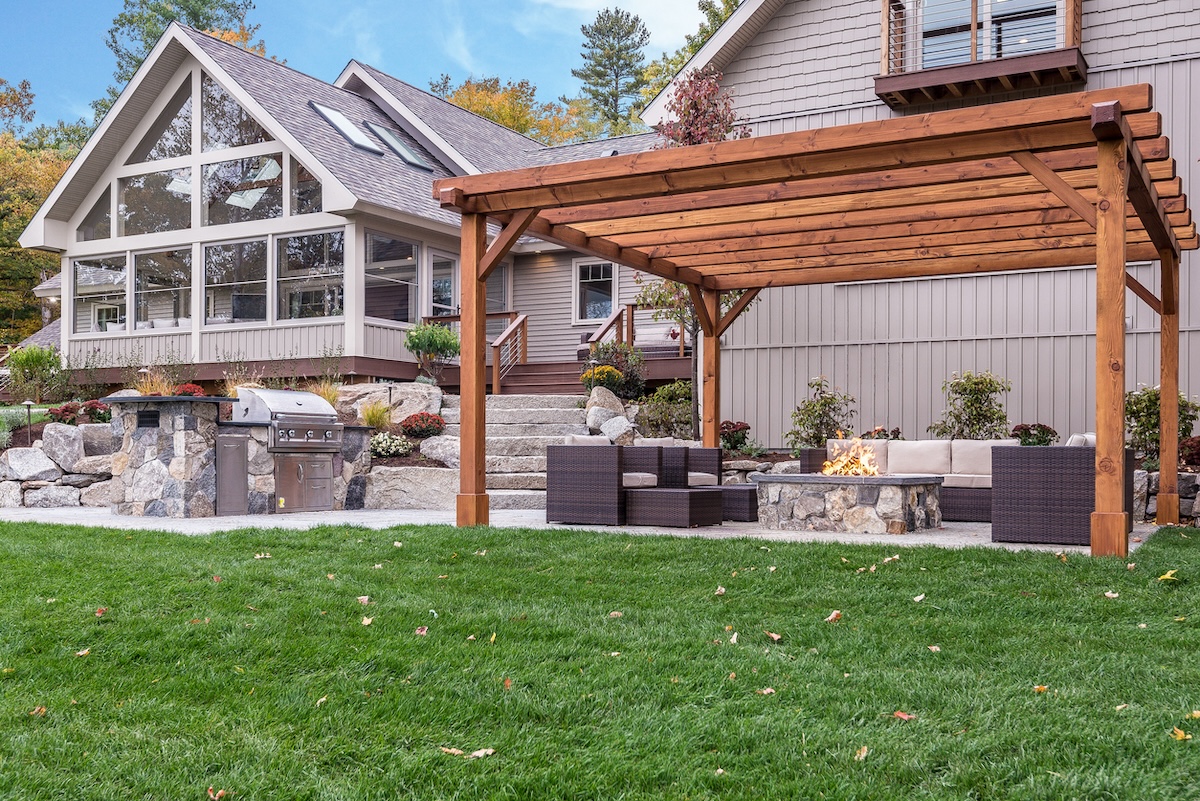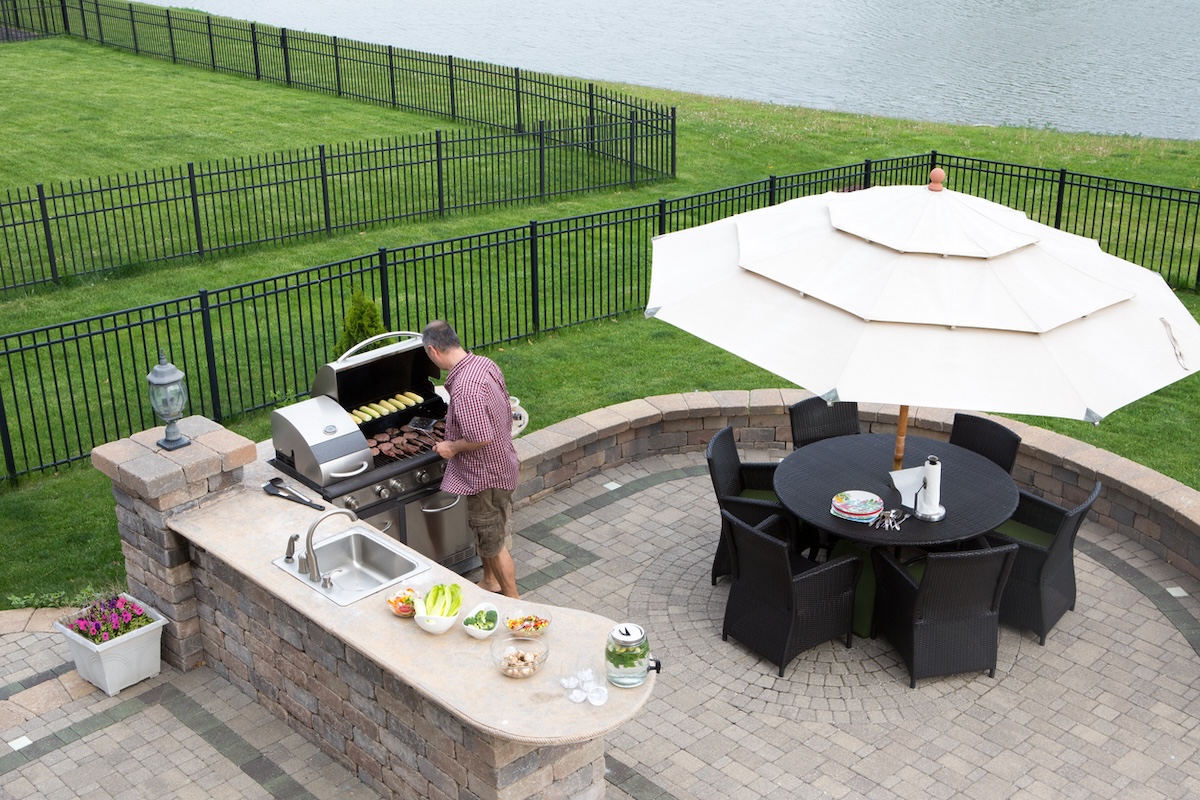

We may earn revenue from the products available on this page and participate in affiliate programs. Learn More ›
The most attractive homes display a special balance of softscape and hardscape landscaping features. While most people don’t realize it, a landscape design or plan relies on much more than simply the lawn and garden. Elements like pathways, the driveway, a deck or patio, plus enhancements like gazebos and fountains, help create the most interesting and functional outdoor space possible.
According to Evan Davis Santi, president of Urban Plantscapes LLC in New York, hardscape design involves the integration of non-living elements to create structure and functionality within outdoor spaces. Keep reading to learn what is hardscaping, the difference between hardscape and softscape elements, benefits of hardscaping, types of hardscaping features to choose from, and how to incorporate hardscaping into a property’s landscape design.
Hardscape vs. Softscape in Landscaping

Landscape design encompasses two major categories: hardscaping and softscaping. According to Santi, non-living elements “can include features such as concrete pavers, outdoor kitchens, decking, retaining walls, and more. These elements form the backbone of the landscape, providing durability and architectural definition.” Hardscape materials to create these elements are essentially everything in the landscape that isn’t living, such as stone, brick, concrete, gravel, asphalt, cinder blocks, and wood.
Softscaping, on the other hand, focuses on the living, natural elements that bring vitality and beauty to outdoor environments. Softscaping consists of plants, trees, shrubs, grasses, flowers, perennials, annuals, and ground covers. “Softscaping adds color, texture, and dimension to the landscape, fostering a sense of harmony with nature,” says Santi. “By harmonizing hardscaping and softscaping, landscape designers create balanced and inviting outdoor settings that cater to both functional needs and aesthetic preferences,” he says.
Benefits of Hardscaping
Hardscape construction serves a variety of beneficial purposes in landscape design. According to Santi, hardscaping materials “expand living spaces and enhance aesthetics to reduce maintenance and control erosion, all while providing opportunities for personalization and creative expression.” These are specific benefits that hardscaping can provide to homeowners:
- Enhances aesthetics: Improves the overall look of the property and helps boost curb appeal.
- Increases property value: Adds value to the home, making it more attractive to potential buyers, who often are drawn to properties with hardscaping features like decks and outdoor kitchens.
- Expands outdoor living space: Backyard hardscapes extend usable space outdoors for relaxation and entertainment activities like cooking and sitting by the pool.
- Aids in stability and longevity of the property: Garden hardscape materials and features like retaining walls improve the structural integrity of the landscape, ensuring durability over time.
- Controls drainage and soil erosion: The materials can help manage water runoff, reducing flooding and erosion risks.
- Improves drought tolerance: Because hardscaping does not require frequent watering like plants do, it allows people to maintain an attractive yard even during dry seasons and droughts.
- Allows for improved accessibility: Walking paths, patios, and decks help make the property more accessible to visitors and to gardens or outdoor living spaces.
- Reduces maintenance time: Hardscaping features tend to require less upkeep than living elements, with less watering, weeding, mowing, and trimming.
Types of Hardscape
Hardscaping is also a way to save some money in the long run. Maintaining softscaping such as trees, flowers, and turf can quickly get expensive, so integrating hardscape ideas into the design can help cut maintenance costs while retaining an attractive and user-friendly yard. Try either DIY hardscaping or hire hardscape contractors for any desired hardscaping services.
Walkway

Commonly built using brick, gravel, stones, or concrete, walkways provide convenient paths that lead from one part of the property to another. They help improve accessibility and connect different parts of a yard, such as the front door to the driveway. The American Society of Landscape Architects suggests using permeable pavers for walkways to reduce water pollution since they allow for natural filtration. Permeable surfaces also help return water to the soil and water table below.
Driveway

Driveways are functional and practical parts of any property, and they can boost the appearance of the exterior when done well. This includes choosing the most attractive materials practical for budget and function. Driveways are commonly constructed using concrete, asphalt, stone, gravel, brick, pavers, turf, and even rubber.
Patio

Built on the ground level, patios serve as an extension of a home and offer a convenient area to congregate outdoors. They can be located in the backyard, front yard, or on the side of the house, and are often made of concrete, decomposed granite, baked clay bricks, gravel, paving stones, and other types of hardscaping materials.
Deck

Decks are a way to add extra space to the yard for relaxing and entertaining. Because they are built higher than a patio, they can provide gorgeous views of the surrounding landscape. Decks can be made from pressure-treated lumber or a more durable composite material, which consists of a combination of wood particles and plastic.
Freestanding Structure

Freestanding structures—such as pergolas, gazebos, arbors, and trellises—serve as a focal point in a yard, adding height, beauty, and luxury or character. They vary in size, features, and materials and are a great choice for people looking for a special spot for spending time outdoors. Some also add shade, privacy, and a place to sit or lie down.
Water Feature

Water features like ponds, lakes, waterfalls, fountains, water walls, and pools add a calming element to the landscape. There are many options at all price points and sizes, so cost, upkeep, and benefits can vary. A carefully placed water feature also adds some cooling effects, noise reduction, and might attract and support wildlife.
Retaining Wall

Typically used to prevent erosion or to make a sloped area more usable, a retaining wall is installed for both functional and aesthetic purposes. They are made from different materials, like concrete, bricks, stone, or wood.
Fence

Fences provide privacy but can also alter the look of a property depending on the material and color chosen. A white picket fence, for example, provides a very different aesthetic than a chain link fence or a block wall.
Fire Pit

Everyone loves roasting marshmallows over an open fire, so adding a fire pit to a home can boost value and appeal. They are a wonderful place for people to gather and create a relaxing, and even romantic, environment. Fire pits can be constructed in a wide range of sizes and out of a variety of materials, such as brick, river rock, stacked stone, flagstone, limestone, concrete, metal, or composite material.
Outdoor Kitchen

Outdoor kitchens can add both convenience and a sense of luxury to any backyard patio or deck. They extend entertaining space to enjoy cooking and dining throughout the year.
How to Use Hardscaping in Your Landscape Design
Use hardscaping when looking to expand the outdoor living space and entertainment areas through options like patios, decks, freestanding structures, and outdoor kitchens. If facing erosion, drainage, or drought problems, look to hardscaping like a retaining wall or terraced structure for a solution. And to personalize an area, boost curb appeal, and raise property value, consider adding attractive hardscaping features like water elements, a fire pit, or an upscale driveway.
To get started, consider the current landscape, climate, style of the home, goals, and budget. Evaluate what can be done as a DIY project and also contact a contractor for advice and assistance. “When planning your landscape design, remember to integrate both hardscaping and softscaping thoughtfully,” suggests Santi. “Start with hardscaping first to establish structure, then add softscapes or plantings afterward. This approach ensures a smoother process and will speed up your landscape makeover.”
